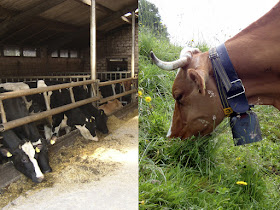A new study led by the Research Institute of Organic Agriculture, which was published in the scientific journal of the Royal Society Interface, shows that reducing concentrate feed can be a feasible alternative for ensuring food security in a climate-friendly way.
Calculations using a model show that, should the predictions of the FAO become a reality, agriculture’s negative impact on the environment will increase significantly by 2050. One of the main reasons is the intensive feeding of livestock of crops like wheat, maize and soy. In order to intensify production, already diminishing cropland is increasingly used for feed production instead of the production of plant-based food. Thus, concentrate feed for animals competes with food for human consumption.
The study shows that by reducing the production of concentrate feed, more plant-based food can be produced while also protecting the environment and reducing GHG emissions. Calculations show that the number of animal products in human diets would decrease by 53 percent if feed production on cropland were to be reduced. This would mostly concern pork, poultry and eggs.
The connection between meat consumption and environmental damage of agriculture has long been a controversial topic. A common conclusion is to further intensify animal husbandry, ie to produce more high-energy concentrate feed on arable land. It is often regarded as the only way to meet the increasing demand for animal-based food and to reduce GHG per kg meat.
However, the new FiBL study also shows that reducing concentrate feed would be a more sustainable solution for supplying the global population with food. According to the calculations, this strategy has great potential and ideally complements already existing approaches for food security like improving the efficiency of food production, distribution and use as well as decreasing consumption.
Newly developed model can be used for a variety of purposes
Researchers at FiBL, the FAO, Alpen-Adria University in Vienna and the University of Aberdeen designed a global model system in order to calculate various scenarios of food availability and impacts of food production on the environment. This model system is able to calculate the complex material flows and resulting production volumes and environmental impacts of our food system.
This allows for an in-depth analysis of changes in production methods and food consumption. The system is consistent with global statistics of the FAO and can be used in the future to answer various questions on the sustainability of agricultural and food systems.
Calculations using a model show that, should the predictions of the FAO become a reality, agriculture’s negative impact on the environment will increase significantly by 2050. One of the main reasons is the intensive feeding of livestock of crops like wheat, maize and soy. In order to intensify production, already diminishing cropland is increasingly used for feed production instead of the production of plant-based food. Thus, concentrate feed for animals competes with food for human consumption.
The study shows that by reducing the production of concentrate feed, more plant-based food can be produced while also protecting the environment and reducing GHG emissions. Calculations show that the number of animal products in human diets would decrease by 53 percent if feed production on cropland were to be reduced. This would mostly concern pork, poultry and eggs.
The connection between meat consumption and environmental damage of agriculture has long been a controversial topic. A common conclusion is to further intensify animal husbandry, ie to produce more high-energy concentrate feed on arable land. It is often regarded as the only way to meet the increasing demand for animal-based food and to reduce GHG per kg meat.
However, the new FiBL study also shows that reducing concentrate feed would be a more sustainable solution for supplying the global population with food. According to the calculations, this strategy has great potential and ideally complements already existing approaches for food security like improving the efficiency of food production, distribution and use as well as decreasing consumption.
Newly developed model can be used for a variety of purposes
Researchers at FiBL, the FAO, Alpen-Adria University in Vienna and the University of Aberdeen designed a global model system in order to calculate various scenarios of food availability and impacts of food production on the environment. This model system is able to calculate the complex material flows and resulting production volumes and environmental impacts of our food system.
This allows for an in-depth analysis of changes in production methods and food consumption. The system is consistent with global statistics of the FAO and can be used in the future to answer various questions on the sustainability of agricultural and food systems.
Read the study HERE.
Visit FiBL's sustainability assessment pages HERE.
The Global Miller
This blog is maintained by The Global Miller staff and is supported by the magazine GFMT
which is published by Perendale Publishers Limited.
For additional daily news from milling around the world: global-milling.com


No comments:
Post a Comment